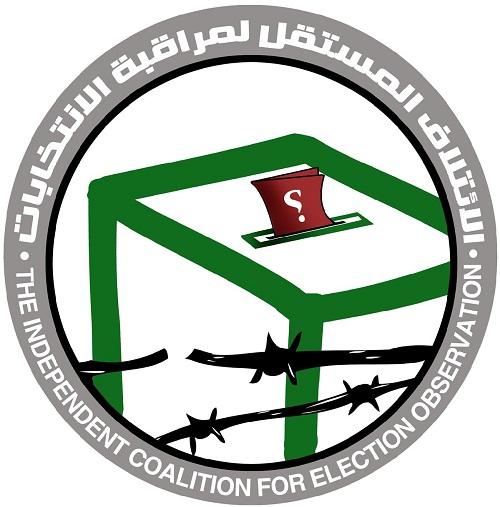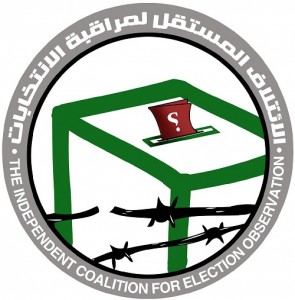The third phase of the elections is distinguished by the fact that it seems superfluous for the majority while offering the final chance for other parties to compete for second and third place. The third and final round of elections concludes a poll that has lasted more than two months—the longest ever inEgypt—which helps to explain the gradual decline in media coverage, which reached its nadir in the third phase. Another reason for the relatively less intense media coverage is that the third round coincided with significant events that overshadowed the elections and pushed them off the front page, most importantly the raid on several NGOs and their offices and the Mubarak trial.
Press coverage of the third round of voting
1. Moratorium on campaigning: still no compliance
Media coverage of the third round of elections was marked by the same professional shortcomings observed in the first and second rounds of voting. Media monitoring and field reports issued by various bodies have alerted all parties to the electoral process of the need to respect the campaigning moratorium. Candidates’ violation of the moratorium has been reported by the media, while the media’s violation of the moratorium has been criticized by media monitoring reports.
ONTV was the only TV channel that adhered to the principle of electoral silence. Among television channels, CBC was the most prone to violating the moratorium, featuring ongoing, brief reviews of prominent candidates in various provinces the night before the polls open.
All newspapers—state-owned, private, and weeklies—consistently violated the moratorium on campaigning. Al-Gomhouriya published an ad for the Hurriya Party over both days of the moratorium, as well as an informational ad for candidate Yasser al-Gindi in its January 2 edition, without noting that the news item was a paid ad. Al-Tahrir again published its special insert helping voters to choose 24 hours before the polls opened.
2. Events bring a sectarian perspective to the fore
Although sectarian media coverage declined in the second round of elections, it returned in force in coverage of the third round. The third round, which included the governorate of Minya, known for its relatively large Coptic population, coincided with the defamatory illustrations in Assyout (covered by al-Gomhouriya on January 2). It also overlapped with Coptic celebrations of Christmas and the New Year and saw various fatwas issued on the permissibility of joining Copts for Christmas celebrations or congratulating them on their holidays. A sectarian perspective was seen in several headlines in newspapers such as al-Masry al-Youm, al-Shorouk, and al-Tahrir (January 2). In addition, questions were again raised about Islamist parties’ stance on Coptic women, a Coptic president, and the construction of churches, and these issues were discussed in newspaper and television interviews with leaders of religious parties (Egyptian Channel, January 2).
3. Attacks on Islamists in headlines, right of response in the story
The media has proved incapable of understanding that its negative coverage of Islamist parties brings a backlash and translates into additional votes for these parties, which appear weak, persecuted, and victimized by the media. This is perhaps not the intent of the constant attacks on Islamist groups. In a final media attempt to resist the rise of the Islamists in the run-up to the third round, the media maintained balance, diversity, and professionalism in its election pages and programs while moving the negative coverage from the elections pages to other sections that do not usually address electoral issues, such as pages and programs on art, women, tourism, the economy, and technology. This tactic was pursued in particular by the weekly Sawt al-Umma (January 2), al-Masry al-Youm, and Roz al-Youssef in their arts sections, which carried headlines such as “Famous Figures Challenge the Salafis after They Take the Majority,” and “Art Is Stronger Than Religious Parties,” both of which investigated the fears of celebrities, especially female artists, about artistic endeavors in the aftermath of the rise of Islamist parties. In its issue of January 2, al-Shorouk carried a piece titled “Parliament from an NDP Majority to a ‘Hear and Obey’ Majority: the Guidance Bureau Supplants the Policies Secretariat and al-Shater Replaces Ezz,” clearly associating the Freedom and Justice Party with the dissolved National Democratic Party.
4. The third round: more professional improprieties
The period under review saw most media outlets engage in several types of professional misconduct, revealing their biases. Each report focused on a set of significant lapses in media coverage, including the use of anonymous sources, a confusion of opinion with news, and the use of misleading photos with news stories. In addition to these, this report found:
- A clear confusion about the facts on the part of correspondents, indicative of their poor professionalism, as noted in the first report. On CBC, Lamis al-Hadidi reported that the Freedom and Justice Party and al-Nour had fielded no candidates inSouth Sinai, while on the same day the correspondent for al-Hayat stated that these parties had fielded candidates. CBC reported that voter turnout in Minya was low, while al-Hayat stated that more than 1 million people voted, one of the highest turnouts of all governorates.
- Akhbar al-Youm (December 31) and CBC (January 3) continued to publish preliminary assessments of the vote after the first day of the poll or even before the poll, which constitutes an unacceptable assumption of the outcome that may influence voters and their choices, particularly when it is not based on any polling or scientific criteria other than the correspondents’ own impressions and the expectations of their sources. This conduct, criticized by previous reports, was seen in many media outlets.
- Newspapers continued to publish articles about candidates without noting their candidacy, or gave them space on the opinion pages to defend their positions and that of their parties or attack their opponents. This conflicts with professional rules that require newspapers to suspend articles by candidates, particularly during the campaigning moratorium.
5. The third round: early indicators confirmed
In the first phase of elections, it was difficult to predict media biases or assess media outlets’ stances on official state bodies. This does not mean that it is assumed that such biases must exist, but rather that it was difficult to know what stance media outlets would take on the different parties to the electoral process and monitor any changes. Observations over the course of the elections, however, have revealed the following attitudes and patterns:
- Al-Masry al-Youm was the paper most focused on the nature of the relationship between the military and the Muslim Brothers and the impact of this relationship on the revolutionaries and other political actors. The paper persistently posed questions about this relationship in all its interviews with all parties, and it selected quotes from Islamist leaders that indicated some link with the military (January 1 and 2).
- Al-Tahrir brought the most obvious sectarian perspective to its electoral coverage. Having carried headlines and stories with a sectarian cast on the first and second round of voting, as noted in the reports, the paper pursued the same tactic in the run-up to the third round. A piece in the January 2 edition carried the headline, “Minya: the Coptic Triangle Faces off against the Islamist Triangle.” On page 2 of the same issue, another story was titled, “From Tahrir to Assyout, the Quran with the Cross.” Although this headline was largely positive, the subheads in the piece were not: “al-Nour Says Explicitly, We Don’t Want a Christian Ruler or a Civil State,” and “Bikar: We Congratulate Christians on Social Occasions, Not Religious Occasions”.
- Al-Gomhouriya was the most dedicated defender of the government and Interior Ministry, an attitude made increasingly clear through quantitative measures (the space devoted to the government) and qualitative measures such as the content of its coverage. The paper consistently highlighted the achievements of government personnel and defended their positions, which was crystallized in its year-end review published on January 1, 2012, with the front-page headline, “On Behalf of Himself and the Residents of al-Khusus, the Mayor of al-Khusus Expresses His Love, Appreciation, and Full Support for the Policemen Who Restored Security and Stability to the Egyptian Street”.
- Roz al-Youssef newspaper attacked Islamist parties and groups more than any other paper. This was very clear in its headlines, which clearly merged opinion and fact, and its editorials, which usually contained extremely negative descriptions of Islamists, such as “Salafis Work for the Mossad inEgypt” (a full-page story published on Friday, December 30). In its issue of January 2, it carried a long interview with Dr. Nawal al-Saadawi; as its teaser on the front page, it used this quote: “The age of patriarchy has ended, the Islamists must leave”.
- The Hayat channel was the most prominent defender of the Wafd Party. The channel not only hosted Wafd leaders on its screens, but it campaigned for them by reporting their statements and news from the party’s operations room, which documented the violations of all parties (for example, al-Hayat Today on January 3). It closely followed the party president (al-Hayat Now, January 3) and gave expansive coverage to all of his campaign rallies. It also regularly cited the Wafd Party in its reports of electoral violations, complaints, and measures taken.
6. Women in the third round
The rise of Islamist parties in the elections influenced media coverage of women in the elections. Islamist parties evoked women’s issues in the media in their statements about women, and their fatwas regarding the permissibility of women running for office and voting. Gradually, Islamist campaigning for female candidates caught the attention of the media, and some parties even mimicked their campaign style after observing wide social acceptance of these methods in some governorates (the Wafd removed the photo of one female candidate). In general, CBC was the only channel that showed an interest in the campaign rallies of women parliamentary candidates and conducted interviews with them, focusing on the role of women in the parliament. Al-Ahram on January 2 devoted one page to a discussion of women between empowerment and marginalization and women in parliament and on party lists.
Violating all professional norms, al-Fajr used women to attack Islamist parties in its January 2 issue, carrying three headlines for different stories: “The Wife of a Salafi Tells Her Story,” “The Sexual and Political Exploitation of Muslim Brother Women,” and “Islamist Forces Based Their Campaigns on Contempt for Women”.
7. Religious channels
After Islamists won the greatest share of votes in the first two rounds of the elections, in the third round the religious channels no longer needed to attack other forces with the same vehemence seen in the run-up to the earlier polls. Instead, a new stage was inaugurated based largely on exclusion, marginalization, and utter disregard for the existence of other forces. The religious channels (al-Rahma and al-Nas) began to discuss the third round of voting as if the outcome were already known, abandoning campaigning for thoughts about how to administer Islamic governance. All programming was devoted to Islamic discussions of how to distribute roles, who would lead the opposition, and how to legislate. Programs asked whether there should even be an opposition, or whether consultation among Muslims was sufficient to administer the country’s affairs, as was the case on the program, “The People Choose,” on al-Rahma.
Share this Post


